The Eslick Store and Office was constructed in 1933 as a mercantile and visitor check-in, the final component in the family’s Cottage Court lodging business. The following is a brief history of the Smith-Eslick Cottage Court and some of the key figures in the Smith and Eslick families.
Cottage Court
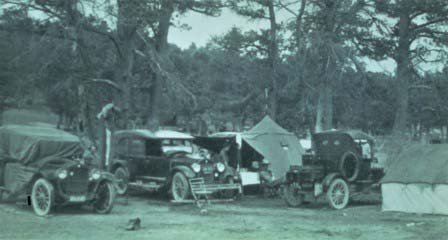
The Smith-Eslick Cottage Court is a humble building with an amazing story. It was built by three generations of one family as part of their auto-tourist lodging business in about 1915. That was just when Rocky Mountain National Park opened and visitors were increasingly coming to town in automobiles, not stagecoaches.
It is thought to be the oldest original-condition “motor court,” the precursor to modern motels, in the region and perhaps anywhere. Because its design, architecture, and purpose are so unusual, it is written into the National Register of Historic Places and the Colorado Register even though it had to be moved to prevent its demolition in 2009.

Although we recognize that Clyde Eslick and his father, Alfred Eslick, played the most important roles in the design and building of the Cottage Court, they wouldn’t have done so without the guidance of Clyde’s grandfather, P.H. Smith who founded the family’s sawmill and construction company business.
No one knows for sure when the Cottage Court was constructed; Clyde’s wife Grace wrote after Clyde’s death that he helped build it in 1911, which seems unlikely. The State Historical Fund chose to make the date of construction 1915, which coincides with the opening of Rocky Mountain National Park. Others claim that it wasn’t built until 1918.
At any rate, P.H. Smith, his son-in-law Alfred Eslick, and a young Clyde Eslick built what is now called the Cottage Court on a 50’ x 100’ lot east of Vine Street and south of Grand Avenue. For those who remember, it backed up against what became the bowling alley property. The building was moved to its present location in 2009 to prevent its demolition.
The Cottage Court became the first business in Grand Lake to cater specifically to auto-tourists, providing protection for visitors and their automobiles. The family later added small cabins and cottages, a second Cottage Court-like structure, and the Eslick Store and Office, a small store/visitor check-in.
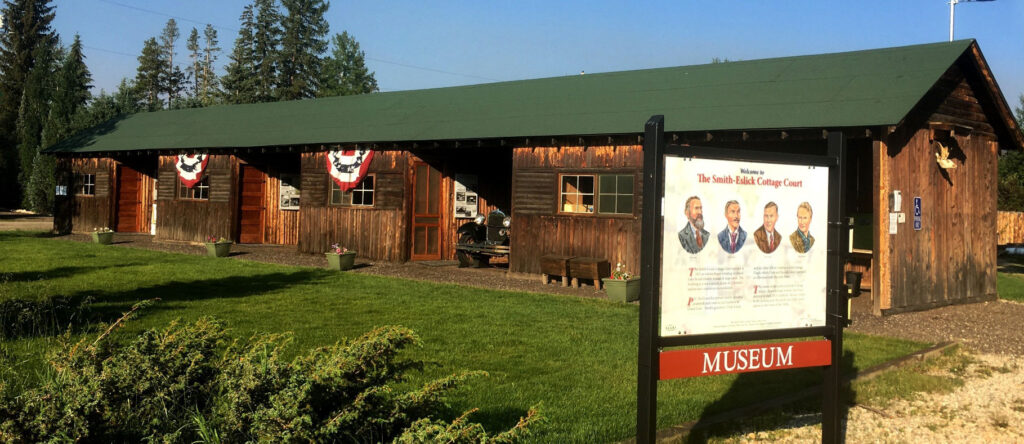
P.H. Smith

Preston Henry “P.H.” Smith was born into a successful Wisconsin farming family in 1847, but P.H. always seemed to want more. In 1880, he set out for Colorado, leaving his wife Mary and three daughters in Kansas, and settling first in Breckenridge. There he and a partner started a successful sawmill business.
Already an ambitious entrepreneur, P.H. soon visited Middle Park and bought several parcels of land in Grand Lake, which had become the supply town for silver and lead mines in the surrounding mountains. The town had several small summer hotels, and P.H. saw its potential for even more visitation. P.H.’s family joined him to settle in Grand Lake.
P.H. started a sawmill business near Fraser; for a few years, his middle daughter Georgia worked with him stacking wood shingles during the week, returning home on weekends.
P.H. later began a sawmill north of what was Sun Valley Ranch on County Road 491, and built a stable and a carpentry shop in Grand Lake, eventually constructing over thirty cabins and homes as well. In 1902, he built his first hotel, the 60-room Bellevue Hotel, and was the contractor who built the Grand Lake Yacht Club in 1912. The Bellevue completely burned in 1912, but P.H. built a second hotel, the Nowata, on that site in 1915, which also burned down in 1921.
P.H. was a respected pioneer entrepreneur of the community; he was instrumental in getting the Cottage Court built circa 1915, and the Community House in Town Park built in 1920, was Deputy Assessor for Grand County, a member of the School Board, raised six children, and more. P.H. became successful, but he and his extended family suffered as many dreadful setbacks as they did wonderful successes.
Alfred & Georgia Eslick
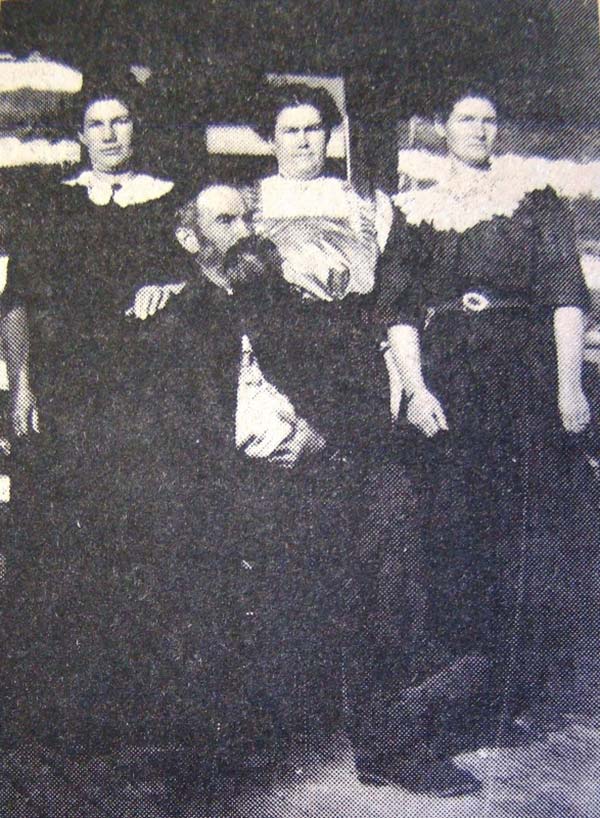
Of P.H. Smith’s three oldest daughters, the one most important to the Cottage Court was his second daughter Georgia. She was born in 1876 in Kansas and eventually came to settle with her family in Grand Lake. She worked at her father’s Fraser area sawmill beginning in 1892, but in 1894 moved on her own to Idaho Springs where she waitressed in a boarding house. It was there, at age 18, that she met and married an English miner, Alfred Eslick, and birthed the first of their seven children in 1895.
Alfred Eslick began showing signs of lung trouble after over ten years working in the mines, so Georgia and he, with their then five children, moved to Grand Lake in 1904. The Smith and Eslick Families were incredibly hardworking people. Georgia opened a commercial laundry, doing wash for other hotels and homes, even as she was raising babies, including one born after they got to Grand Lake. When P.H.’s Nowata Hotel burned in 1915, Georgia continued her laundry business in the burned-out basement of the hotel.
Alfred hired on with his father-in-law, P.H. Smith, to learn tree cutting, sawmill work, and building construction. Alfred, with his son Clyde, was one of the builders of the Cottage Court; he also became the town’s shoe repairman, worked as a school janitor and soon was caretaker for many Grand Lake homes. In summers, Georgia and Alfred managed the Cottage Court following its construction ca. 1915.
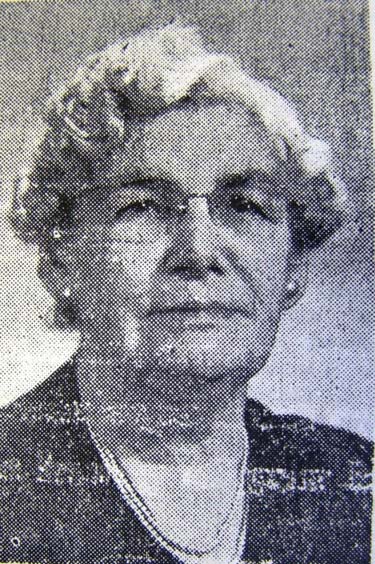
From 1906 to 1934, P.H. Smith gave his daughter Georgia several pieces of property, two for the Eslick family to build a house, others with auto-tourist lodgings for Georgia to manage. These properties were the original location of the Cottage Court and other lodging structures, now where the Rocky Mountain Repertory Theatre is located.
Alfred died in 1931, leaving Georgia to manage the Cottage Court and the family’s lodging business. Georgia continued the Cottage Court business on her own with the help of her son Clyde. People remember Georgia sitting in the bay window of the Eslick Store and Office building, then at the corner of Grand Avenue and Vine Street. Youngsters would wave at her as they skipped by. When she died in 1956, Clyde and his wife, Grace, assumed management of the business.
Clyde & Grace Eslick
Clyde Eslick left school at age 10, after fourth grade, and worked for his grandfather, P.H. Smith, to help support the family. Every member of the Smith and Eslick families had to help with the family’s sawmill and construction business, or in some other way bring home income. Life in Grand Lake was not easy… always work to be done.
He was already a big-for-his-age young man, so Clyde went to work cutting and skidding logs at P.H.’s sawmill. Lumber was brought into Grand Lake, stacked for drying, planed at Smith’s planer mill, and used to build cottages and homes, many still standing. Through his work at the sawmill and construction business, Clyde learned carpentry and picked up masonry skills as well. He would use his woodworking skills when he and his father, with his grandfather’s guidance, designed and built the Cottage Court.
At about the same time, Clyde began work with the Granby Freight Company, delivering loads between Grand Lake and the railroad which came to Granby in 1905. A sled with two horses was used in winter, but Clyde got to drive a Model-T in summer, and he fell in love with automobiles.

The Model-T had a cloth roof, so Clyde certainly learned quickly the importance of having a “garage” of some sort. Also, early automobiles carried everything they might need for repairs with them; service stations were few. Ford produced by far the most popular car of the time so almost everyone had the same tires. If your automobile was not secure, someone who needed a tire might just take yours. Clyde and his father Alfred designed the unique Cottage Court with carports that provided cover and were adjacent to the guest room so far more secure.
In 1920, when Clyde was about 19, he was hired as a hostler, servicing engines or acting as a train fireman, with the Rollins Pass Road south of what is now Winter Park. He later drove the railroad engines with huge snowplows at their fronts, called “Mallets” through extremely deep snow on the rails. Clyde left this work after a year, returning to Grand Lake and the construction business.
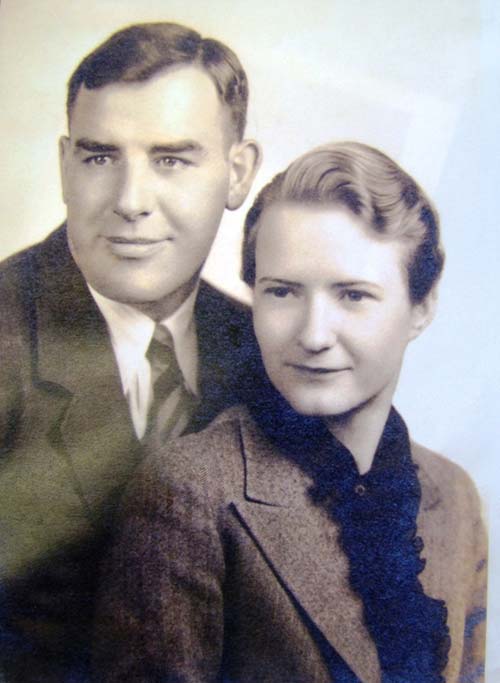
Clyde married schoolteacher Grace Strobel in 1938. In 1940, drilling of the Alva B. Adams Tunnel, part of the Colorado-Big Thompson water diversion project began here in Grand Lake. Like many other locals, Clyde was hired on to work “the tunnel”; he mastered dynamite blasting.
When his mother, Georgia Eslick, died in 1956, Clyde and his wife assumed management of the business. Clyde would bring a small pile of firewood to each guest room, clean the wood stoves, talk with guests about how they were to act while visiting, and handle whatever else was needed. All that for $1.50 a night in the 1920s.! Clyde is remembered so fondly by locals who’d sit with him on a bench at the original Cottage Camp listening to his great stories.
Clyde and Grace moved the store and office across the street to its present location and removed other small buildings as well. Clyde and Grace closed the business completely in the early 1960s; the Cottage Court had been a true business for almost 50 years!
Clyde Eslick was called “Mr. Grand Lake” for being the citizen who had lived the longest in town. Over the years, he served as the caretaker of the Grand Lake Cemetery, a member of the first Board of Trustees when the Town incorporated in 1944, and Town Marshal. Like his father Alfred, he took care of countless summer homes and had a huge plywood board of hanging house keys in his workshop.
Loren Eslick
Loren Eslick was the last child of Albert and Georgia Eslick, born in Grand Lake in 1907. He was the usual kind of rowdy, mischievous boy raised in this rugged mountain community. Being the last in a line of seven children, he may have been a little pampered. He was healthy and grew to be a large, strong man. He worked in logging, carpentry, and building. He became quite proficient in this line.
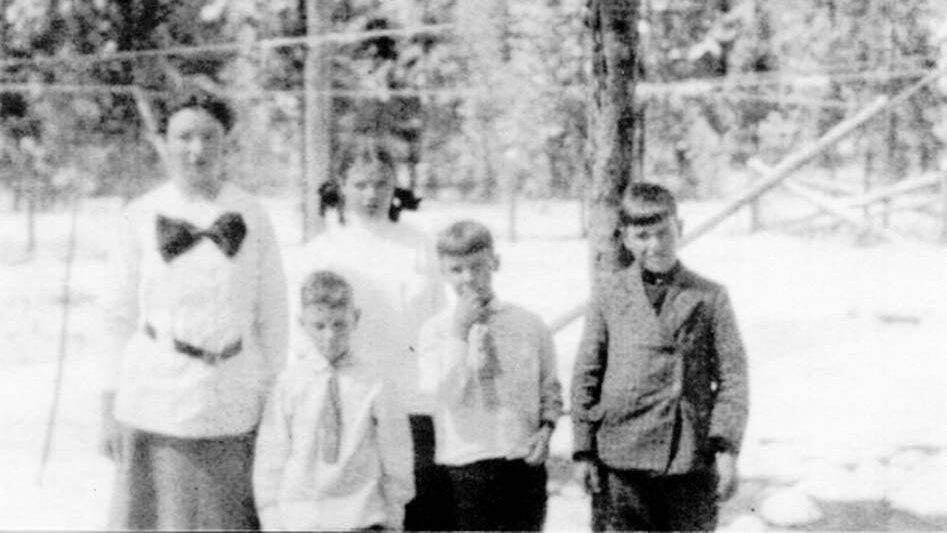
At one time he built a good-sized store building kitty-cornered across the front corner of the Eslick lots. His dreams were high for the store he would run with himself as a popular merchanthe would handle all sorts of general merchandise and have a pot-bellied stove around which his friends and neighbors might come to sit and pass the time of day or the long snow-filled winter months.
He finished his building but something happened. He never stocked the building with any merchandise. His dreams vanished as he became ill with a kidney infection, which heckled him for the rest of his days and led to his early death in 1934.
Loren’s passing left a gap in the lives of his parents and friends. His building, the Eslick Store and Office, stood idle for some time and then was used as a rental dwelling for large families. In time, it became a storage house and eventually was moved across the street where it still stands — a storehouse rather lonely and almost sad in its long waiting days.